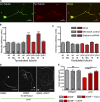Local axonal function of STAT3 rescues axon degeneration in the pmn model of motoneuron disease
- PMID: 23109669
- PMCID: PMC3483126
- DOI: 10.1083/jcb.201203109
Local axonal function of STAT3 rescues axon degeneration in the pmn model of motoneuron disease
Abstract
Axonal maintenance, plasticity, and regeneration are influenced by signals from neighboring cells, in particular Schwann cells of the peripheral nervous system. Schwann cells produce neurotrophic factors, but the mechanisms by which ciliary neurotrophic factor (CNTF) and other neurotrophic molecules modify the axonal cytoskeleton are not well understood. In this paper, we show that activated signal transducer and activator of transcription-3 (STAT3), an intracellular mediator of the effects of CNTF and other neurotrophic cytokines, acts locally in axons of motoneurons to modify the tubulin cytoskeleton. Specifically, we show that activated STAT3 interacted with stathmin and inhibited its microtubule-destabilizing activity. Thus, ectopic CNTF-mediated activation of STAT3 restored axon elongation and maintenance in motoneurons from progressive motor neuronopathy mutant mice, a mouse model of motoneuron disease. This mechanism could also be relevant for other neurodegenerative diseases and provide a target for new therapies for axonal degeneration.
Figures






Similar articles
-
Mechanisms for axon maintenance and plasticity in motoneurons: alterations in motoneuron disease.J Anat. 2014 Jan;224(1):3-14. doi: 10.1111/joa.12097. Epub 2013 Sep 6. J Anat. 2014. PMID: 24007389 Free PMC article. Review.
-
Neurofilament depletion improves microtubule dynamics via modulation of Stat3/stathmin signaling.Acta Neuropathol. 2016 Jul;132(1):93-110. doi: 10.1007/s00401-016-1564-y. Epub 2016 Mar 28. Acta Neuropathol. 2016. PMID: 27021905 Free PMC article.
-
Axonal defects in mouse models of motoneuron disease.J Neurobiol. 2004 Feb 5;58(2):272-86. doi: 10.1002/neu.10313. J Neurobiol. 2004. PMID: 14704958
-
Spatiotemporally limited BDNF and GDNF overexpression rescues motoneurons destined to die and induces elongative axon growth.Exp Neurol. 2014 Nov;261:367-76. doi: 10.1016/j.expneurol.2014.05.019. Epub 2014 May 27. Exp Neurol. 2014. PMID: 24873730
-
Actions of CNTF and neurotrophins on degenerating motoneurons: preclinical studies and clinical implications.J Neurol Sci. 1994 Jul;124 Suppl:77-83. doi: 10.1016/0022-510x(94)90187-2. J Neurol Sci. 1994. PMID: 7807152 Review.
Cited by
-
STAT3 signal that mediates the neural plasticity is involved in willed-movement training in focal ischemic rats.J Zhejiang Univ Sci B. 2016 Jul;17(7):493-502. doi: 10.1631/jzus.B1500297. J Zhejiang Univ Sci B. 2016. PMID: 27381726 Free PMC article.
-
Neurotransmitter release in motor nerve terminals of a mouse model of mild spinal muscular atrophy.J Anat. 2014 Jan;224(1):74-84. doi: 10.1111/joa.12038. Epub 2013 Mar 13. J Anat. 2014. PMID: 23489475 Free PMC article.
-
Altered interplay between endoplasmic reticulum and mitochondria in Charcot-Marie-Tooth type 2A neuropathy.Proc Natl Acad Sci U S A. 2019 Feb 5;116(6):2328-2337. doi: 10.1073/pnas.1810932116. Epub 2019 Jan 18. Proc Natl Acad Sci U S A. 2019. PMID: 30659145 Free PMC article.
-
Intrinsic mechanisms of neuronal axon regeneration.Nat Rev Neurosci. 2018 Jun;19(6):323-337. doi: 10.1038/s41583-018-0001-8. Nat Rev Neurosci. 2018. PMID: 29666508 Free PMC article. Review.
-
Mechanisms for axon maintenance and plasticity in motoneurons: alterations in motoneuron disease.J Anat. 2014 Jan;224(1):3-14. doi: 10.1111/joa.12097. Epub 2013 Sep 6. J Anat. 2014. PMID: 24007389 Free PMC article. Review.
References
Publication types
MeSH terms
Substances
LinkOut - more resources
Full Text Sources
Molecular Biology Databases
Miscellaneous

